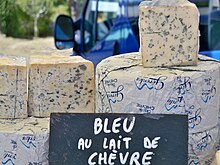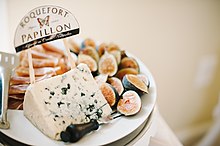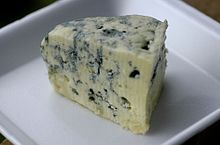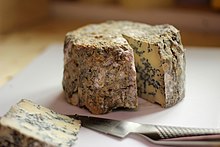
Rennet is a complex set of enzymes produced in the stomachs of ruminant mammals. Chymosin, its key component, is a protease enzyme that curdles the casein in milk. In addition to chymosin, rennet contains other enzymes, such as pepsin and a lipase.

Roquefort is a sheep milk blue cheese from southern France. Though similar cheeses are produced elsewhere, EU law dictates that only those cheeses aged in the natural Combalou caves of Roquefort-sur-Soulzon may bear the name Roquefort, as it is a recognised geographical indication, and has a protected designation of origin.

Salami is a cured sausage consisting of fermented and air-dried meat, typically pork. Historically, salami was popular among southern, eastern, and central European peasants because it can be stored at room temperature for up to 45 days once cut, supplementing a potentially meager or inconsistent supply of fresh meat. Countries and regions across Europe make their own traditional varieties of salami.
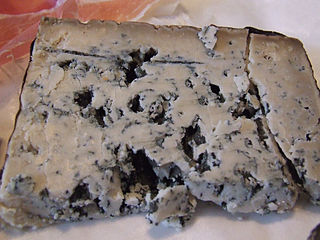
Cabrales is a blue cheese made in the artisan tradition by rural dairy farmers in Asturias, Spain. This cheese can be made from pure, unpasteurized cow’s milk or blended in the traditional manner with goat and/or sheep milk, which lends the cheese a stronger, spicier flavor.

Cheesemaking is the craft of making cheese. The production of cheese, like many other food preservation processes, allows the nutritional and economic value of a food material, in this case milk, to be preserved in concentrated form. Cheesemaking allows the production of the cheese with diverse flavors and consistencies.
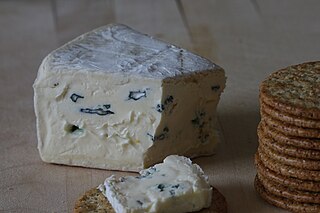
Cambozola is a cow's milk cheese that is a combination in style of a French soft-ripened triple cream cheese and Italian Gorgonzola.

Bleu d'Auvergne is a French blue cheese, named for its place of origin in the Auvergne region of south-central France. It is made from cow's milk, and is one of the cheeses granted the Appellation d'origine contrôlée from the French government.

Penicillium glaucum is a mold that is used in the making of some types of blue cheese, including Bleu de Gex, Rochebaron, and some varieties of Bleu d'Auvergne and Gorgonzola.

Fermented tofu is a Chinese condiment consisting of a form of processed, preserved tofu used in East Asian cuisine. The ingredients typically are soybeans, salt, rice wine and sesame oil or vinegar. In mainland China the product is often freshly distributed. In overseas Chinese communities living in Southeast Asia, commercially packaged versions are often sold in jars containing blocks 2- to 4-cm square by 1 to 2 cm thick soaked in brine with select flavorings.

Penicillium roqueforti is a common saprotrophic fungus in the genus Penicillium. Widespread in nature, it can be isolated from soil, decaying organic matter, and plants.
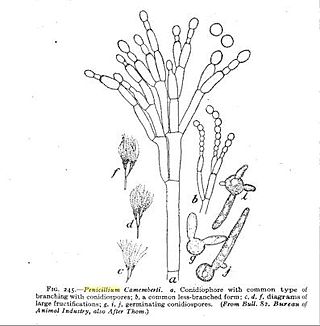
Penicillium camemberti is a species of fungus in the genus Penicillium. It is used in the production of Camembert, Brie, Langres, Coulommiers, and Cambozola cheeses, on which colonies of P. camemberti form a hard, white crust. It is responsible for giving these cheeses their distinctive flavors. An allergy to the antibiotic penicillin does not necessarily imply an allergy to cheeses made using P. camemberti.

Cheese is a dairy product produced in a range of flavors, textures, and forms by coagulation of the milk protein casein. It comprises proteins and fat from milk. During production, milk is usually acidified and either the enzymes of rennet or bacterial enzymes with similar activity are added to cause the casein to coagulate. The solid curds are then separated from the liquid whey and pressed into finished cheese. Some cheeses have aromatic molds on the rind, the outer layer, or throughout.

Aristolochene is a bicyclic sesquiterpene produced by certain fungi including the cheese mold Penicillium roqueforti. It is biosynthesized from farnesyl pyrophosphate by aristolochene synthase and is the parent hydrocarbon of a large variety of fungal toxins.

There are many different types of cheese. Cheeses can be grouped or classified according to criteria such as length of fermentation, texture, methods of production, fat content, animal milk, and country or region of origin. The method most commonly and traditionally used is based on moisture content, which is then further narrowed down by fat content and curing or ripening methods. The criteria may either be used singly or in combination, with no single method being universally used.

Roquefortine C is a mycotoxin that belongs to a class of naturally occurring 2,5-diketopiperazines produced by various fungi, particularly species from the genus Penicillium. It was first isolated from a strain of Penicillium roqueforti, a species commercially used as a source of proteolytic and lipolytic enzymes during maturation of the blue-veined cheeses, Roquefort, Danish Blue, Stilton and Gorgonzola.

Cheese ripening, alternatively cheese maturation or affinage, is a process in cheesemaking. It is responsible for the distinct flavour of cheese, and through the modification of "ripening agents", determines the features that define many different varieties of cheeses, such as taste, texture, and body. The process is "characterized by a series of complex physical, chemical and microbiological changes" that incorporates the agents of "bacteria and enzymes of the milk, lactic culture, rennet, lipases, added moulds or yeasts, and environmental contaminants". The majority of cheese is ripened, except for fresh cheese.
Microbial food cultures are live bacteria, yeasts or moulds used in food production. Microbial food cultures carry out the fermentation process in foodstuffs. Used by humans since the Neolithic period fermentation helps to preserve perishable foods and to improve their nutritional and organoleptic qualities. As of 1995, fermented food represented between one quarter and one third of food consumed in Central Europe. More than 260 different species of microbial food culture are identified and described for their beneficial use in fermented food products globally, showing the importance of their use.

Sour cream is a dairy product obtained by fermenting regular cream with certain kinds of lactic acid bacteria. The bacterial culture, which is introduced either deliberately or naturally, sours and thickens the cream. Its name comes from the production of lactic acid by bacterial fermentation, which is called souring. Crème fraîche is one type of sour cream with a high fat content and less sour taste.
Enzyme-modified cheese (EMC) is a concentrated cheese flavour ingredient that is produced from cheese by treatment with enzymes such as proteases, lipases and esterases. An incubation period under controlled conditions is required for proper flavor development.These enzymes accelerate and intensify the ripening of cheese, which is normally done with enzymes released by an microbial culture. They may be added to during cheesemaking, after the cheese curds have been pressed, or even after the cheese has been naturally aged. EMCs were first made in the 1970s.
